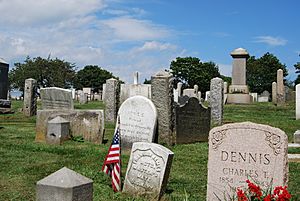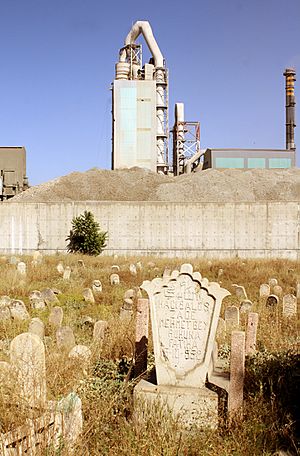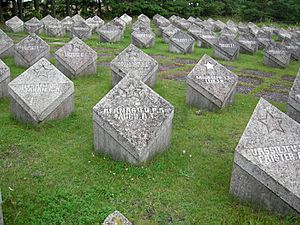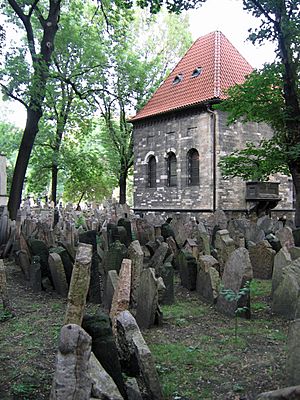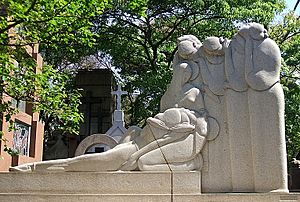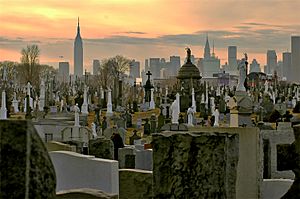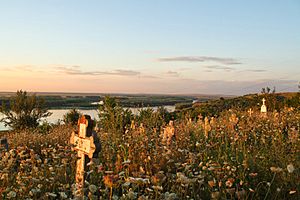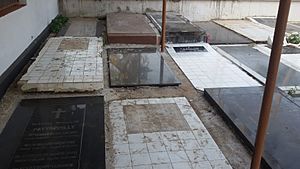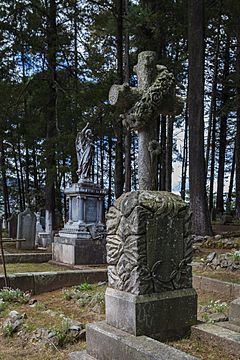Cemetery facts for kids
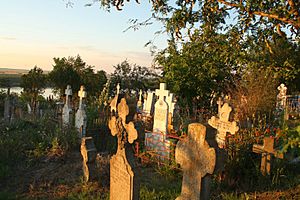
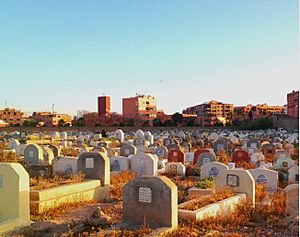
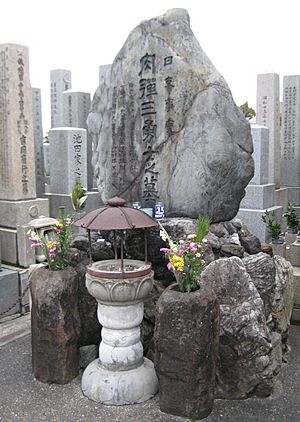
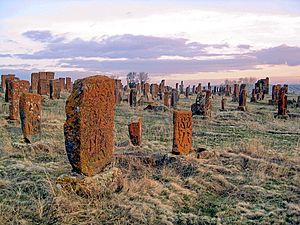
A cemetery or graveyard is a place where the remains of dead people are buried or otherwise interred. The word cemetery (from Greek κοιμητήριον, "sleeping place") implies that the land is specifically designated as a burial ground. The term graveyard is often used interchangeably with cemetery, but primarily referred to a burial ground within a churchyard.
The intact or cremated remains of people may be interred in a grave, commonly referred to as burial, or in a tomb, an "above-ground grave" (resembling a sarcophagus), a mausoleum, columbarium, niche, or other edifice. In Western cultures, funeral ceremonies are often observed in cemeteries. These ceremonies or rites of passage differ according to cultural practices and religious beliefs. Modern cemeteries often include crematoria, and some grounds previously used for both, continue as crematoria as a principal use long after the interment areas have been filled.
Contents
Types
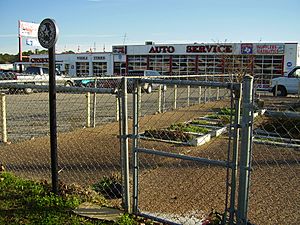
There are a number of different styles of cemetery in use. Many cemeteries have areas based on different styles, reflecting the diversity of cultural practices around death and how it changes over time.
Urban
The urban cemetery is a burial ground located in the interior of a village, town, or city. Early urban cemeteries were churchyards, which filled quickly and exhibited a haphazard placement of burial markers as sextons tried to squeeze new burials into the remaining space. As new burying grounds were established in urban areas to compensate, burial plots were often laid out in a grid to replace the chaotic appearance of the churchyard. Urban cemeteries developed over time into a more landscaped form as part of civic development of beliefs and institutions that sought to portray the city as civilized and harmonious.
Many urban cemeteries are characterized by multiple burials in the same grave. Multiple burials is a consequence of the limited size of the urban cemetery, which cannot easily expand due to adjacent building development. It was not uncommon for an urban cemetery to begin adding soil to the top of the cemetery, to create new burial space.
Monumental
A monumental cemetery is the traditional style of cemetery where headstones or other monuments made of marble, granite or similar materials rise vertically above the ground (typically around 50 cm but some can be over 2 metres high). Often the entire grave is covered by a slab, commonly concrete, but it can be more expensive materials such as marble or granite, and/or has its boundaries delimited by a fence which may be made of concrete, cast iron or timber. Where a number of family members are buried together (either vertically or horizontally), the slab or boundaries may encompass a number of graves. Monumental cemeteries are often regarded as unsightly due to the random collection of monuments and headstones they contain. Also, as maintenance of the headstones is the responsibility of family members (in the absence of a proscribed Perpetual Care and Maintenance Fund), over time many headstones are forgotten about and decay and become damaged. For cemetery authorities, monumental cemeteries are difficult to maintain. While cemeteries often have grassed areas between graves, the layout of graves makes it difficult to use modern equipment such as ride-on lawn mowers in the cemetery. Often the maintenance of grass must be done by more labour-intensive (and therefore expensive) methods. In order to reduce the labour cost, devices such as string trimmers are increasingly used in cemetery maintenance, but such devices can damage the monuments and headstones. Cemetery authorities dislike the criticism they receive for the deteriorating condition of the headstones, arguing that they have no responsibility for the upkeep of headstones, and typically disregard their own maintenance practices as being one of the causes of that deterioration.
Rural or garden
The rural cemetery or garden cemetery is a style of burial ground that uses landscaping in a park-like setting. It was conceived in 1711 by the British architect Sir Christopher Wren, who advocated the creation of landscaped burial grounds which featured well-planned walkways which gave extensive access to graves and planned plantings of trees, bushes, and flowers. Wren's idea was not immediately accepted. But by the early 1800s, existing churchyards were growing overcrowded and unhealthy, with graves stacked upon each other or emptied and reused for new burials. As a reaction to this, the first "garden" cemetery—Père Lachaise Cemetery in Paris—opened in 1804. Because these cemeteries were usually on the outskirts of town (where land was plentiful and cheap), they were called "rural cemeteries", a term still used to describe them today. The concept quickly spread across Europe.
Garden/rural cemeteries were not necessarily outside city limits. When land within a city could be found, the cemetery was enclosed with a wall to give it a garden-like quality. These cemeteries were often not sectarian, nor co-located with a house of worship. Inspired by the English landscape garden movement, they often looked like attractive parks. The first garden/rural cemetery in the United States was Mount Auburn Cemetery near Boston, Massachusetts, founded by the Massachusetts Horticultural Society in 1831.
The cost of building a garden/rural cemetery often meant that only the wealthy could afford burial there. Subsequently, garden/rural cemeteries often feature above-ground monuments and memorials, mausoleums, and columbaria. The excessive filling of rural/garden cemeteries with elaborate above-ground memorials, many of dubious artistic quality or taste, created a backlash which led to the development of the lawn cemetery.
Lawn
Traditional lawn
A lawn cemetery (as the name suggests) is covered in grass. Each grave is marked with a commemorative plaque (around 30 cm x 20 cm is typical) placed horizontally at the head of the grave at ground-level. While families are normally still involved in the design and information contained on the plaque, cemetery authorities generally constrain the size and materials of the plaque and often strongly encourage (or in some cases mandate) the use of a standard design.
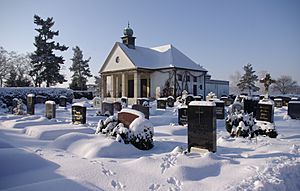
Typically, lawn cemeteries comprise a number of graves in this lawn setting with trees and gardens on the perimeter. Adolph Strauch introduced this style in 1855 in Cincinnati. While aesthetic appeal to family members has been the primary driver for the development of lawn cemeteries, cemetery authorities initially welcomed this new style of cemetery enthusiastically, expecting easier maintenance. Selecting (or grading) the land intended for a lawn cemetery so that it is completely flat allows the use of large efficient mowers (such as ride-on mowers or lawn tractors) - the plaques (being horizontally set in the ground) lie below the level of the blades and are not damaged by the blades. Unfortunately, in practice, while families are often initially attracted to the uncluttered appearance of a lawn cemetery, the common practice of placing flowers (sometimes in vases) and increasingly other items (e.g. small toys on children's graves) re-introduces some clutter to the cemetery and makes it difficult to use the larger mowers. While cemetery authorities increasingly impose restrictions on the nature and type of objects that can be placed on lawn graves and actively remove prohibited items, grieving families are often unwilling to comply with these restrictions and become very upset if the items are removed. Another problem with lawn cemeteries involves grass over-growth over time: the grass can grow over and cover the plaque, to the distress of families who can no longer easily locate the grave. Grasses that propagate by an above-ground stolon (runner) can cover a plaque very quickly. Grasses that propagate by a below-ground rhizome tend not to cover the plaque as easily.
Lawn beam
The lawn beam cemetery, a recent development, seeks to solve the problems of the lawn cemetery while retaining many of its benefits. Low (10–15 cm) raised concrete slabs (beams) are placed across the cemetery. Commemorative plaques (usually standardised in terms of size and materials similar to lawn cemeteries) stand on these beams adjacent to each grave. As in a lawn cemetery, grass grows over the graves themselves. The areas between the beams are wide enough to permit easy mowing with a larger mower. As the mower blades are set lower than the top of the beam and the mowers do not go over the beam, the blades cannot damage the plaques. Up on the beam, the plaques cannot be easily overgrown by grass, and spaces between the plaques permit families to place flowers and other objects out of reach of the mowing.
Natural
A natural cemetery or eco-cemetery or green cemetery is a new style of cemetery and is an area set aside for natural burials (with or without coffins). Natural burials are motivated by a desire to be environmentally conscious with the body rapidly decomposing and becoming part of the natural environment without incurring the environmental cost of traditional burials. Although in principle natural burial can be performed in any style of cemetery, typically the environmental motivations of those requesting natural burial tend to favor the use of a natural bushland or woodland setting for the natural burial. Because of the number of trees usually present in a natural cemetery, burials occur in whatever location and orientation best fits the natural environment as opposed to the more traditional rows or other orderly arrangements in traditional cemeteries. As a consequence, natural burial may actually be less efficient land-use than a traditional cemetery. However, because of the rapid decomposition of a natural burial, in principle the re-use of the grave site can occur earlier than in other conventional burials, which would improve the efficiency of land use. However, it remains to be seen if family members will accept the early re-use of natural burial sites, given the general community dislike of re-use of any kind of grave. Another consequence of the lack of orderly burials is the need for highly accurate surveying of the grave site for effective cemetery management, to prevent the accidental re-use of a grave site.
In keeping with the intention of "returning to nature" and the early re-use potential, natural cemeteries do not normally have conventional grave markings such as headstones. Instead, the planting of a tree or bush or placement of a rock is regarded as the more appropriate way to commemorate the dead. However, as with other types of cemetery, the intentions of the cemetery authorities may be in conflict with the grieving practices of family and friends, for whom being able to visit the precise location of a grave and read the headstone is often important. In some natural cemeteries, names can be inscribed on naturally-shaped rocks (not carved headstones) but, unless the rock is particularly large and heavy, it can easily be knocked or kicked to another nearby location.
Columbarium wall
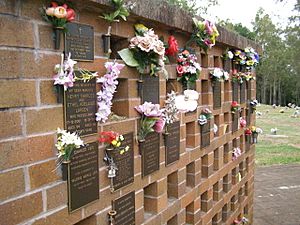
Columbarium walls are a common feature of many cemeteries, reflecting the increasing use of cremation rather than burial. While cremated remains can be kept at home by families in urns or scattered in some significant or attractive place, neither of these approaches allows for a long-lasting commemorative plaque to honour the dead nor provide a place for the wider circle of friends and family to come to mourn or visit. Therefore, many cemeteries now provide walls (typically of brick or rendered brick construction) with a rectangular array of niches, with each niche being big enough to accommodate a person's cremated remains. Columbarium walls are a very space-efficient use of land in a cemetery compared with burials and a niche in a columbarium wall is a much cheaper alternative to a burial plot. A small plaque (about 15 cm x 10 cm) can be affixed across the front of each niche and is generally included as part of the price of a niche. As the writing on the plaques has to be fairly small to fit on the small size of the plaque, the design of columbarium walls is constrained by the ability of visitors to read the plaques. Thus, the niches are typically placed between 1 metre to 2 metres above the ground so the plaques can be easily read by an adult. Some columbarium walls have niches going close to ground level, but these niches are usually unpopular with families as it is difficult to read the plaque without bending down very low (something older people in particular find difficult or uncomfortable to do).
As with graves, the niches may be assigned by the cemetery authorities or families may choose from the unoccupied niches available. It is usually possible to purchase (or pay a deposit) to reserve the use of adjacent niches for other family members. The use of adjacent niches (vertically or horizontally) usually permits a larger plaque spanning all the niches involved, which provides more space for the writing. As with graves, there may be separate columbarium walls for different religions or for war veterans. As with lawn cemeteries, the original expectation was that people would prefer the uncluttered simplicity of a wall of plaques, but the practice of leaving flowers is very entrenched. Mourners leave flowers (and other objects) on top of columbarium walls or at the base, as close as they can to the plaque of their family member. In some cases, it is possible to squeeze a piece of wire or string under the plaque allowing a flower or small posy to be placed on the plaque itself or clips are glued onto the plaque for that purpose. Newer designs of columbarium walls take this desire to leave flowers into account by incorporating a metal clip or loop beside each plaque, typically designed to hold a single flower stem or a small posy. As the flowers decay, they simply fall to the ground and do not create a significant maintenance problem.
Family
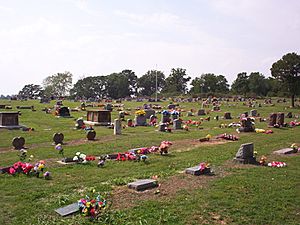
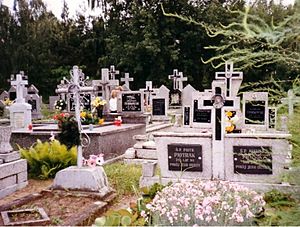
While uncommon today, family (or private) cemeteries were a matter of practicality during the settlement of America. If a municipal or religious cemetery had not been established, settlers would seek out a small plot of land, often in wooded areas bordering their fields, to begin a family plot. Sometimes, several families would arrange to bury their dead together. While some of these sites later grew into true cemeteries, many were forgotten after a family moved away or died out.
Today, it is not unheard of to discover groupings of tombstones, ranging from a few to a dozen or more, on undeveloped land. As late 20th century suburban sprawl pressured the pace of development in formerly rural areas, it became increasingly common for larger exurban properties to be encumbered by "religious easements," which are legal requirements for the property owner to permit periodic maintenance of small burial plots located on the property but technically not owned with it. Often, cemeteries are relocated to accommodate building. However, if the cemetery is not relocated, descendants of people buried there may visit the cemetery.
More recent is the practice of families with large estates choosing to create private cemeteries in the form of burial sites, monuments, crypts, or mausoleums on their property; the mausoleum at Fallingwater is an example of this practice. Burial of a body at a site may protect the location from redevelopment, with such estates often being placed in the care of a trust or foundation. Presently, state regulations have made it increasingly difficult, if not impossible, to start private cemeteries; many require a plan to care for the site in perpetuity. Private cemeteries are nearly always forbidden on incorporated residential zones. Many people will bury a beloved pet on the family property.
Flowers
In Western countries, and many others, visitors to graves commonly leave cut flowers, especially during major holidays and on birthdays or relevant anniversaries. Cemeteries usually dispose of these flowers after a few weeks in order to keep the space maintained. Some companies offer perpetual flower services, to ensure a grave is always decorated with fresh flowers. Flowers may often be planted on the grave as well, usually immediately in front of the gravestone. For this purpose roses are highly common.
Stones
Visitors to loved ones interred in Jewish cemeteries often leave a small stone on the top of the headstone. There are prayers said at the gravesite, and the stone is left on the visitor's departure. It is done as a show of respect; as a general rule, flowers are not placed at Jewish graves. Flowers are fleeting; the symbology inherent in the use of a stone is to show that the love, honor, memories, and soul of the loved one are eternal. This practice is seen in the closing scene of the film Schindler's List, although in that case it is not on a Jewish grave.
Crosses
War graves will commonly have small timber crosses left with a red poppy attached to its centre. These will often have messages written on the cross. More formal visits will often leave a poppy wreath. Jewish war graves are sometimes marked by a timber Star of David.
Candles
Placing burning grave candles on the cemetery to commemorate dead is a very common tradition in Poland. It is mostly practised on All Souls' Day. The traditional grave candles are called znicz in Polish.
Images for kids
-
Cemetery overlooking the Danube, near Cernavodă, Romania
-
A cemetery in Nurmijärvi, Finland
-
Two Colonial era graves in Pemaquid, Maine
-
Flowers left on the grave of Édith Piaf
-
Small stones on a gravestone in a Jewish cemetery in Germany
-
Jewish cemetery "Heiliger Sand" in Worms, Germany
-
Cemetery excavations, like this one in Madrid, can alleviate overcrowding.
-
A belltower at Forest Home Cemetery, in Fifield, Wisconsin. Tolling bells during funerals has been customary in some places around the world.
-
A roadside cemetery in Hualien, Taiwan
-
Cemetery gate, Galisteo, New Mexico
See also
 In Spanish: Cementerio para niños
In Spanish: Cementerio para niños



